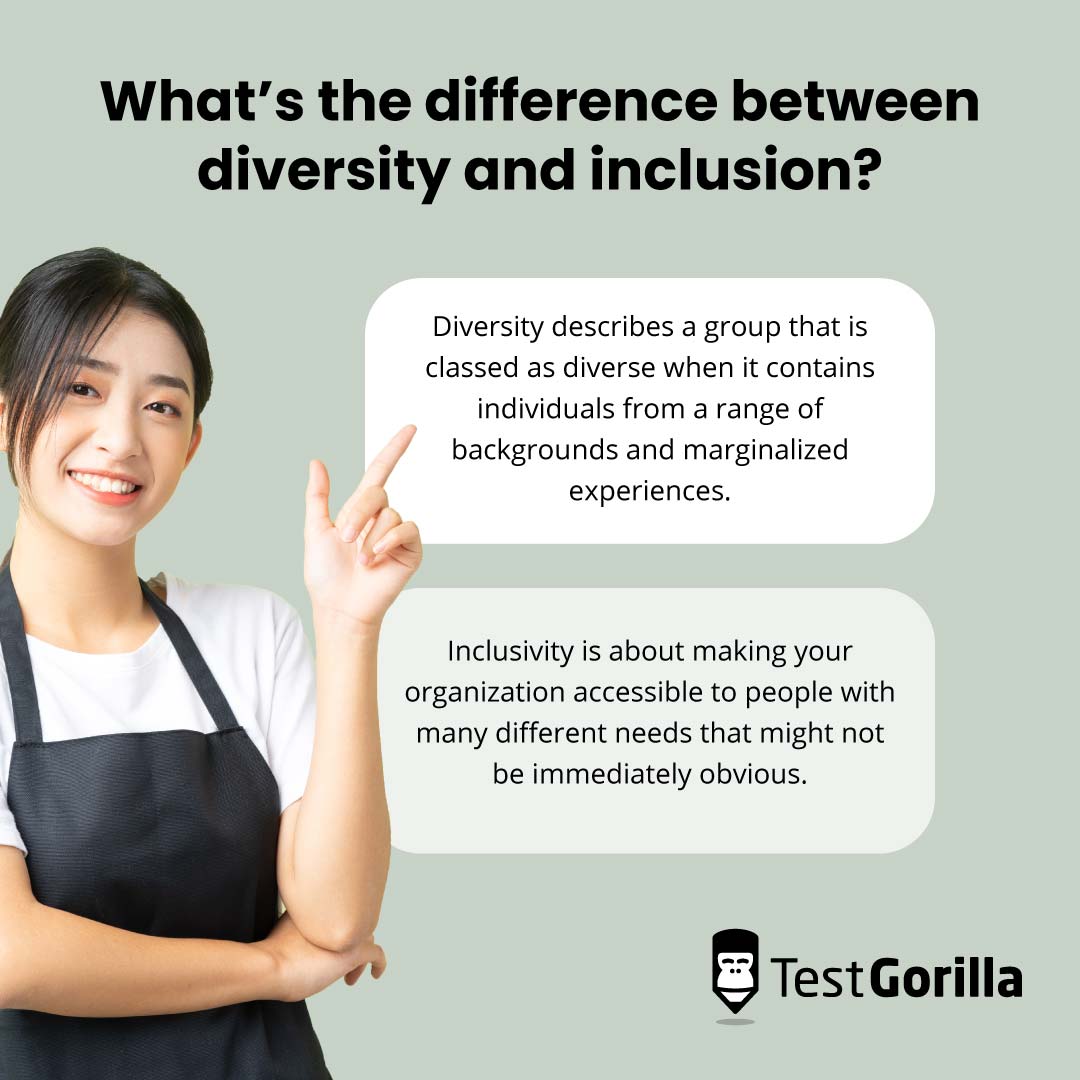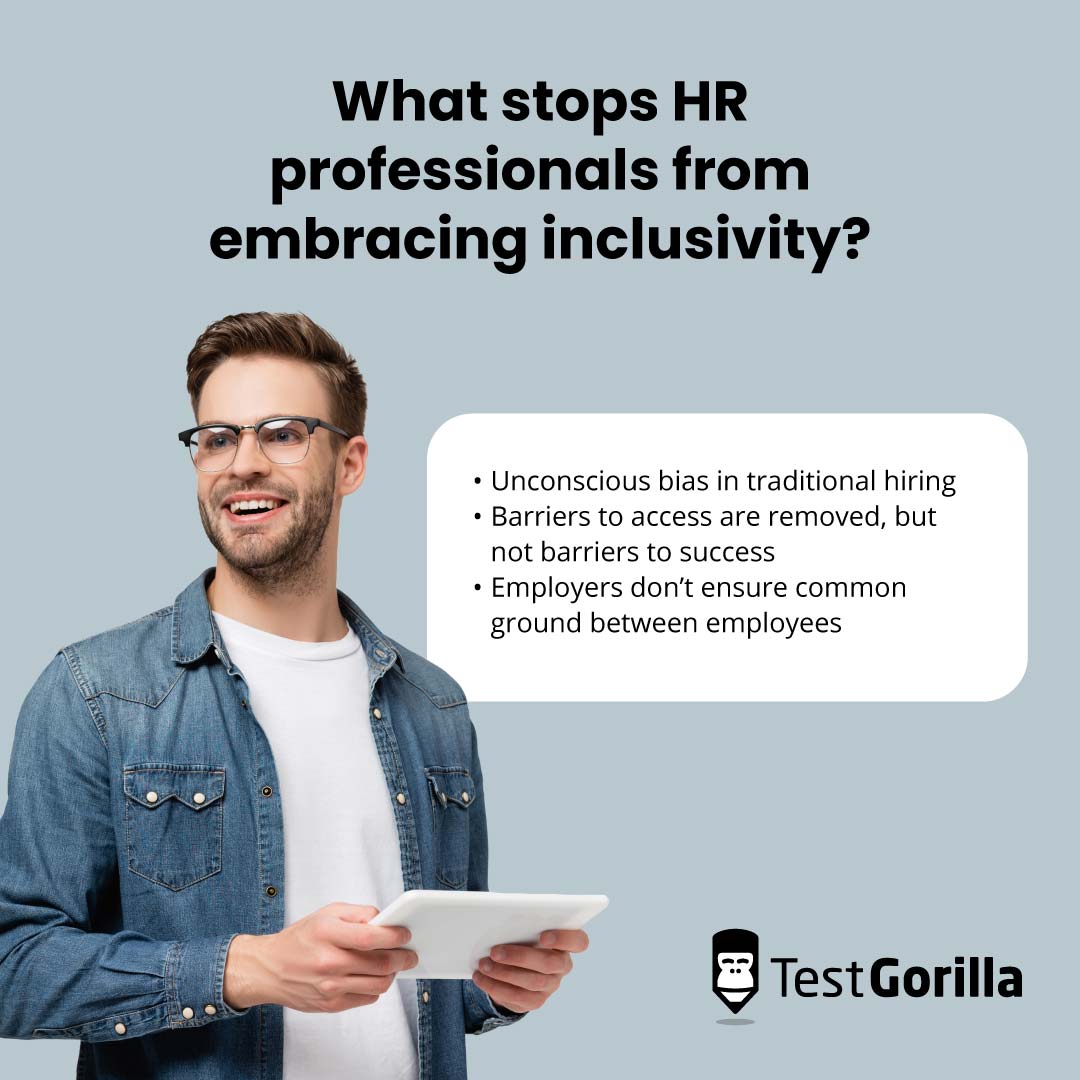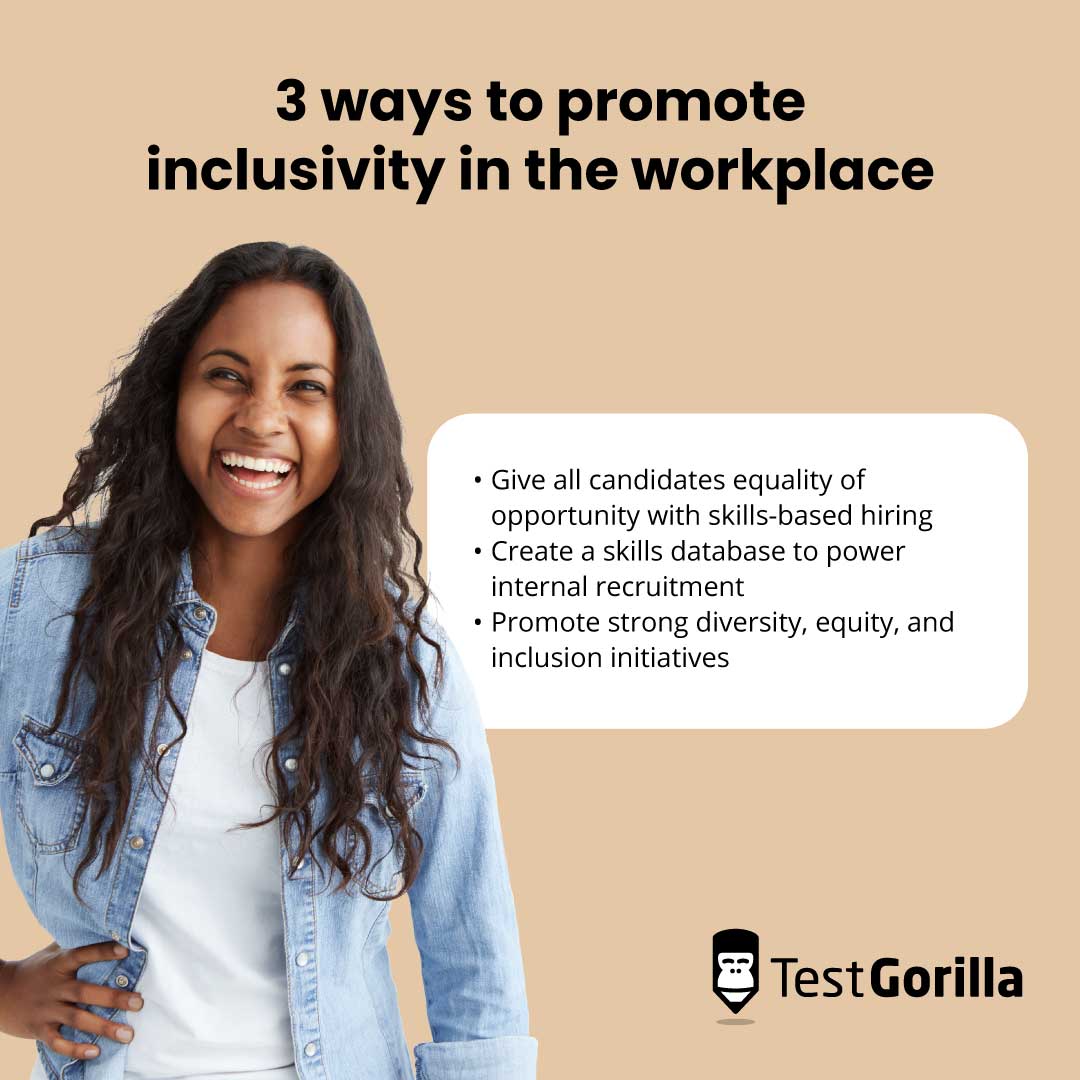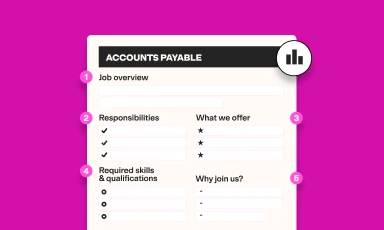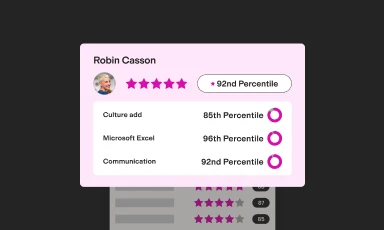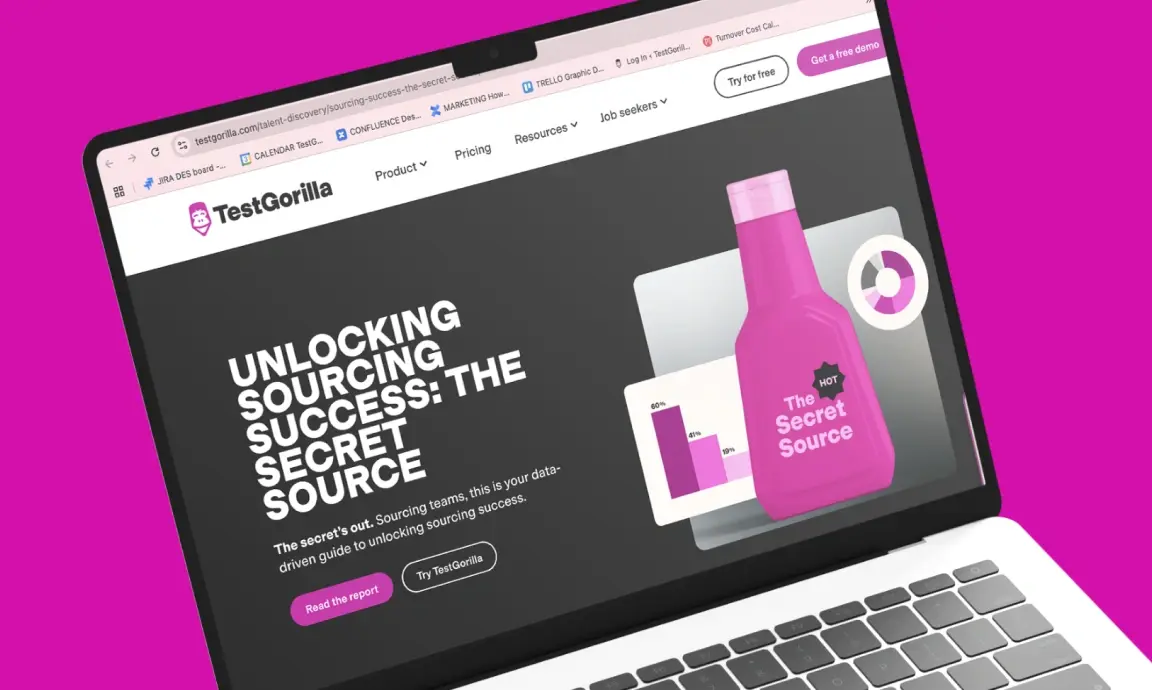Here’s why inclusivity is a growth engine for more than just businesses
We’d all like to believe we live in a meritocracy – that the right person gets hired for the job, and all it takes for them to rise through the ranks is proving their leadership skills.
Unfortunately, that’s rarely how it works.
Systemic inequality means many qualified applicants don’t even make it through the screening processes for most jobs, and decisions about internal promotions are frequently affected by unconscious bias.
It’s obvious that valuable potential is wasted by this system and that capturing that potential can result in benefits for businesses.
But the benefits of inclusivity in the workplace don’t end at your bottom line.
Creating a more inclusive workplace can bring us closer to a more inclusive society.
In this blog, we take you through what inclusivity is, the obstacles to inclusivity in business, and how businesses can commit to inclusive practices.
Let’s start by talking about the difference between diversity and inclusion.
Table of contents
- What’s the difference between diversity and inclusion?
- What gets in the way of inclusivity?
- How to measure diversity and inclusion
- How does diversity and inclusion drive company growth?
- The ripple effect of inclusivity
- 3 ways to promote inclusivity in the workplace
- Get started with inclusive hiring by switching to skills-based recruitment methods
- Sources
What’s the difference between diversity and inclusion?
Diversity and inclusion are terms that are used together so often that it’s easy to forget that they actually refer to separate ideas.
To begin with, diversity doesn’t describe an individual: No one person can be “diverse.” Instead, it describes a group that is classed as diverse when it contains individuals from a range of backgrounds and marginalized experiences.
There are many ways that an individual can bring diversity to your workforce. Some of the most common characteristics people talk about that contribute to diversity in hiring are:
Race
Gender
Sexual orientation
Disability
Neurodiversity
Think of diverse individuals as the ingredients for a successful workforce. Just like when you’re making a meal, too much of one type of ingredient throws off the balance.
If diverse employees are the ingredients for success, inclusive practices are the heat that brings them all together. These are the protocols that help you cater to the diverse needs of your employees and ensure they receive the support they need.
You’ve probably already implemented some inclusivity measures – for example, disability inclusion measures like having a wheelchair-accessible office. You might also have LGBTQ+ inclusion practices in place, such as a Pride Club.
However, inclusivity is about making your organization accessible to people with many different needs that might not be immediately obvious. For example, you might make your workplace more inclusive by:
Promoting neuroinclusivity by making your workplace accessible for autistic workers
Being a trauma-informed workplace
A broad range of inclusive practices is essential to activate the benefits of diversity for businesses (and beyond).
What gets in the way of inclusivity?
If inclusivity is the activating force that enables organizations to get the most out of diversity, you would expect inclusive practices to be in widespread use throughout organizations. And yet, inclusivity is an often-neglected aspect of HR practices.
So, what stops HR professionals from embracing inclusivity?
Unconscious bias in traditional hiring
Many HR leaders might tell you that they would love to build more inclusive practices but that they struggle to get diverse candidates in the door in the first place.
This difficulty stems from the fact that traditional hiring methods are not inclusive because they force hiring managers to fall back on unconscious bias when making hiring decisions, like when screening resumes.
One study found applicants with White-sounding names were 9% more likely than those with Black-sounding names to receive responses to their job applications, even when the content was exactly the same.
Many workplaces still use outdated four-year degree requirements to screen candidates, cutting out those who are Skilled Through Alternative Routes (otherwise known as STARs).
The pattern continues at interviews. Yale University researchers found both male and female scientists preferred to hire men, even after they’d received training on objective hiring.[1]
Traditional hiring doesn’t allow recruiters to measure candidates’ skills directly, and lacking hard data for decision-making means that many employers’ efforts to promote diversity are hampered before employees even get in the door.
Clearly, implicit bias training isn’t enough to combat this.
Barriers to access are removed, but not barriers to success
Even if you are hiring diversely, if you’re not making an equal effort to ensure inclusivity after employees are hired, you may struggle to retain candidates with diverse backgrounds.
Let’s say you’re hiring in a male-dominated field like STEM (science, technology, engineering, and math). It’s one thing to hire women; it’s another to ensure they integrate into a mostly male team and get the same advancement opportunities as their colleagues.
In fact, studies show that women are less likely to be promoted than their male peers, even though they often outperform them in their jobs and are less likely to quit.
Some inclusivity issues are more obvious than others. It might be fairly obvious if your male managers are forming better mentoring relationships with young male recruits than female ones, but it’s less obvious if the inclusivity discrepancy is in a different area.
For instance, one way many organizations try to be more inclusive is by becoming hybrid or remote-friendly workplaces. This practice is more inclusive for working parents and disabled employees.
However, 41% of US executives say remote employees are less likely to be considered for promotions than employees who work from the office. Without these opportunities to advance, these employees will leave your organization.
Even in organizations that do routinely implement diversity and inclusion initiatives, many do so in a merely sequential fashion – doing a push for gender diversity one year, race the next.
This leaves out those who are impacted by multiple marginalizing factors at once and ultimately holds back inclusivity for all.
To counteract this issue, Harvard researchers recommend taking an intersectional approach. This approach enlists marginalized individuals to help in decision-making to remove both:
Barriers to access, which stop marginalized individuals from getting into the organization
Barriers to success, which stop marginalized people from progressing through the organization
This is known as the “Canary Code of Inclusion.” Its basis is that marginalized individuals are the “canaries” who reveal the presence of bias in an organization. If you make your practices inclusive for them, your environment becomes more inclusive for everybody.
Employers don’t ensure common ground between employees
The final factor holding back inclusivity in the workplace is that organizations focus on diversity without ensuring all employees have strong common ground binding them together – or checking if their strengths complement one another.
Researchers have shown “contextual diversity,” which comes from teams comprising a range of backgrounds and institutional experiences, can promote creative problem-solving.[2]
But this must be balanced against “personal diversity,” which is when team members have differences in:
Age
Fluency in the team’s working language
Personality
This research found the wrong mix of personal diversity meant employees found it less enjoyable to spend time together, were less trusting and patient with each other, and experienced more conflict when making decisions.
The best way for organizations to avoid this friction and find common ground for diverse employees is through a strong company culture. Specifically, you should provide a “toolkit” of different values that all employees agree are important.[3]
This enables employees from diverse cultural backgrounds and working styles to draw on different values when approaching business problems, without deviating from a set of agreed practices or attitudes.
For example, the phrase “A good idea can come from anywhere” is a great value for your organization to hold; however, employees might struggle to apply it if they’re from countries where teamwork is less democratic and more hierarchical.
Offering this value alongside one that prioritizes collaboration gives these employees an alternative, empowering them to collaborate with colleagues and submit ideas to a superior.
This gives all employees, regardless of background, a way to approach problems that aligns with your team-focused culture.
The best insights on HR and recruitment, delivered to your inbox.
Biweekly updates. No spam. Unsubscribe any time.
How to measure diversity and inclusion
It’s clear by now that you need to not only be intentional about diversity but also about fostering inclusion and tracking your progress.
You might be tempted to set diversity and inclusion targets, but these are frequently controversial and may end up demotivating your workers.
In fact, studies show that when marginalized candidates are presented with documentation of the “business case for diversity,” they are put off from applying for a role, perhaps because they feel they are being used to fill a quota.
Instead, the outcome you should focus on is consensus amongst your workforce, particularly for marginalized employees.
The Gartner Inclusion Index recommends that organizations measure inclusion by listening to employees’ assessments of the following:[4]
Fair treatment: whether employees are recognized and rewarded fairly
Integrating differences: whether the workplace is a respectful environment for employees
Decision making: whether team members listen to everyone when making decisions
Psychological safety: whether they feel safe to express themselves honestly
Trust: whether they trust the communications they receive from management
Belonging: whether they feel that they are cared for
Diversity: whether the managers reflect the diversity of the workforce
When you measure inclusion this way, you can identify the strengths and weaknesses in your organization’s approach to inclusivity. Then you can create initiatives to embed inclusivity more deeply in your company culture.
If you do this successfully, you’ll see significant business benefits.
How does diversity and inclusion drive company growth?
There are many benefits of diversity in the workplace, first and foremost that it makes for happier employees. This may be due to the fact that a diverse range of characteristics in an organization inspires employees and reassures them that they are accepted as they are.
This happiness manifests first as loyalty. Research shows employees who feel included are more motivated to progress through the ranks and to pursue opportunities for promotion.
When inclusive practices enable diverse employees to succeed and move up the ranks, this benefits engagement and productivity.
Employees who move roles internally are a whopping three times more likely to be engaged than those who just stay in their current roles.
It’s no surprise, then, that diverse companies outperform their competitors.
Organizations that feature in the top quartile for racial and ethnic diversity are 35% more likely than those in the bottom to have above-average financial returns. Those in the top quartile for gender diversity are 15% more likely to outperform financially.[5]
This relationship has strengthened over time, with the correlation between diversity and financial performance mounting year over year since 2017.
All of these factors contribute to the overarching evidence that diversity – when followed through with inclusive practices – boosts productivity and revenue. But the effects go even deeper than your bottom line.
The ripple effect of inclusivity
Clearly, inclusivity drives business growth, but it also has deeper impacts that ripple outward into society.
For individuals
As we’ve already seen, inclusive practices improve employee wellbeing. There is evidence that inclusive practices alleviate employee stress by reducing their experience of bias, harassment, and discrimination.
In fact, the research goes one further: Not only do inclusive practices reduce stress, but they improve employee self-esteem by strengthening their social connections with their peers and by making them feel understood.
These benefits extend into individuals’ lives beyond their work. A powerful example is when employers support working parents by offering extended family leave or onsite daycare facilities.
By giving parents the freedom and support to bond with their children, you contribute massively to their wellbeing and give the next generation a good start in life.
There may be longer-term impacts, too. Evidence shows that equalizing parental income between Black families and White families is more powerful for improving children’s career outcomes than equalizing education.
Real-life example: Patagonia’s onsite childcare
One famous example of inclusive practices affecting individuals comes from the clothing giant Patagonia, which is renowned for onsite childcare and its support of working parents.
The policy started when Melinda Chouinard, the co-founder of Patagonia, parked a trailer in front of the Great Pacific Iron Works in 1983 so that her colleague could nurse her newborn while at work.
As the Iron Works grew and eventually became Patagonia, the organization’s “family-affirming policies” became a bedrock part of its employee benefits.
The chief human resources officer believes this not only brings benefits like tax relief and lower turnover to the business, but also that these policies create healthier families and healthier relationships between parents and their children.[6]
For organizations
We’ve already discussed some of the evidence that a diverse and inclusive workforce can transform your business.
In the case of supporting working parents, there’s ample research supporting the productivity gains organizations can access.
One study conducted in 2020 found businesses that invested in families saw 5.5 times the revenue growth of their competitors thanks to factors like:
Greater innovation
Better retention of talent
Increased productivity
The result is a self-perpetuating cycle, with financial success allowing organizations to channel funds back into their initiatives and to gain a higher profile in business and society at large.
Both of these things enable companies to spread their influence and make a difference in the wider world.
Real-life example: IBM’s long-standing anti-discrimination policies
There are many examples of diversity and inclusion pioneers in the business world, and one of the most famous is IBM, one of the world’s largest IT companies.
IBM has one of the longest-standing anti-discrimination policies in the US, which was penned in 1953.
The policy clearly stated the company’s opposition to discrimination in hiring, 11 years before the Civil Rights Act came into effect and made this discrimination illegal.
IBM’s work didn’t stop there. In the 1990s, the group established eight task forces, each of which was devoted to understanding the inclusion needs of different groups of employees. This included those who were:
Black
Asian
Native American
LGBTQ
Latinx
Men
Women
People with disabilities
They also created networks and mentoring programs for employees from marginalized groups.
When powerful brands like IBM make outspoken changes like this, it sends a strong message to other organizations and people in power to follow suit.
For society
The demand for tools like skills-based hiring to help improve diversity and inclusion in the workplace comes from broad strides toward equality over the past few decades.
One of the most talked-about factors for this forward movement is gender equality. Many researchers have theorized about the huge economic gains that could be made if women were able to participate more fully in the workforce (an area in which inclusive support for parents plays a huge role).
For gender equality in the workplace, getting equal rates of women and men into the workforce is only the first step. Employers need to also have an inclusive culture to retain and promote women.
The top issues fueling workplace gender inequality – including unequal pay, sexual harassment, and fewer women being promoted – can be improved with inclusive policies like offering parental support, detoxifying work culture, and using skills-based assessments to level the playing field for raises and promotions (more on that later).
Addressing these issues has broad economic advantages: McKinsey calculated that if all countries matched the rate of improvement for women of the fastest-improving country in their region, they could add as much as $12tn to the global annual Gross Domestic Product (GDP) in 2025 – an 11% bump.
This is nothing compared to the “full potential” scenario, in which women participate in the labor market to an identical degree as men. This would add as much as $28tn, or 26%, by 2025.[7]
Real-life example: Gender equality and GDP growth in the Nordic countries
The Nordic countries – Denmark, Norway, Sweden, Finland, and Iceland – have long outperformed the rest of Europe when it comes to gender equality.
Nordic countries topped the European Union Gender Equality Index for 2022, and Iceland has closed more than 90% of its gender gap, topping the World Economic Forum’s ranking in the Global Gender Gap Index for the 12th year in a row.
In the Nordic countries, we can see GDP growth that can only be theorized worldwide. By some estimates, increases in women’s employment in Denmark, Iceland, Norway, and Sweden account for around 10-20% of the average annual GDP growth rate since the mid-1960s.[8]
3 ways to promote inclusivity in the workplace
We’ve covered what inclusivity is and the huge ripple effect embracing inclusive practices in your organization can have. To get started with promoting inclusiveness, here are three methods that actually get results.
1. Give all candidates equality of opportunity with skills-based hiring
Remember way back at the beginning of this blog when we talked about the lack of data in traditional hiring? Skills-based hiring is the antidote to that.
With skills testing, you don’t have to rely on flawed tools like resumes, degree requirements, or good old unconscious bias to make a hiring decision. Instead, you can directly observe candidates’ skills by testing them on the core competencies of the role at hand.
This is more inclusive because it provides equality of opportunity. Candidates who would have been excluded can take the test and prove their skills – it doesn’t discriminate based on how and where they developed those skills.
It also ensures all candidates are tested on the same skills, which can be compared using objective data.
This inclusive hiring method unlocks the benefits of diversity as well: 91.1% of organizations saw an increase in diversity after switching to skills-based hiring, according to our 2022 report.
It might be particularly handy in closing the gender employment gap at your organization. One study of more than 2,000 successful job applicants found that the number of women being hired into senior roles increased by almost 70% when skills-based methods were used.
Not only can you test everyone equally on the core skills required for the role, but you can also ensure they have that all-important common ground with your existing team. You can do this by testing them for culture add.
Unlike the traditional concept of culture fit, which looks for candidates who replicate the superficial qualities of your existing team, culture add finds candidates who share your organizational values while also bringing something new to the table. It’s the best way to promote harmonious diversity.
2. Create a skills database to power internal recruitment
Skills-based methods don’t only promote inclusive hiring; they can also help with inclusive promotion.
Once you’ve assessed a new employee’s skills during the hiring process, you should log their results into an internal talent marketplace, a spreadsheet or dedicated piece of software that gives you an overview of the skills within your organization.
As well as logging new employees’ scores on skills tests, you should periodically re-test employees’ skills in key areas to ensure your database is up to date.
This overview of the skills available in your workforce can be very handy when hiring because it shows you who the most qualified internal candidates are, discouraging hiring managers from favoring employees they have relationships with.
It can be especially helpful when heading into a period of organizational restructuring.
An internal talent marketplace can show you the skills you lack in different areas of your business, so you can reduce losses by moving internal candidates into roles for which they have adjacent skills.
As well as helping you manage internal mobility more inclusively, having an internal talent marketplace can also ensure you include all employees in opportunities for skills-based learning.
For instance, while auditing leadership skills, you might surface candidates for management training who were overlooked before.
As we discussed above, improving all employees’ chances for internal mobility and skills development can have huge benefits for attracting and retaining top talent.
3. Promote strong diversity, equity, and inclusion initiatives
Finally – but perhaps most obviously – you need to get some strong diversity, equity, and inclusion initiatives up and running to support your employees. These help skilled workers rise through the ranks and thrive in their existing roles.
Initiatives that might make the working environment more inclusive for employees include:
Remote and hybrid working
Flexitime, the policy whereby employees can choose to move around some of their work hours to accommodate things like doctor’s appointments, childcare, and personal plans
Onsite childcare
However, you should also promote initiatives that help employees thrive outside of work. The concept of holistic HR takes into account not only whether an individual feels supported to perform well in their job, but also to:
Achieve their goals outside of work
Pursue a healthy lifestyle
Look after their mental and physical health
Initiatives that support these outside-of-work factors might include:
Robust health insurance that includes support for mental health, such as counseling sessions
Financial planning and investment support
Get started with inclusive hiring by switching to skills-based recruitment methods
By using inclusive practices to bring together diverse employees, you can foster growth in your employees’ personal lives, the lives of their families, your bottom line, and society more generally.
To make sure you’re lowering the barriers to opportunity at your organization, read our guide to the dos and don’ts of diversity recruiting.
To help promising employees progress within your company regardless of their gender, race, age, or disability, read our complete guide to internal mobility.
For an inclusive way to measure whether a candidate’s right for your culture, use our Culture Add test to hire the best.
Sources
Agarwal, Pragya. (December 3, 2018). “Unconscious Bias: How It Affects Us More Than We Know”. Forbes. Retrieved April 28, 2023. https://www.forbes.com/sites/pragyaagarwaleurope/2018/12/03/unconscious-bias-how-it-affects-us-more-than-we-know/
Taras, Vasyl, et al. (June 9, 2021). “Research: How Cultural Differences Can Impact Global Teams”. Harvard Business Review. Retrieved April 28, 2023. https://hbr.org/2021/06/research-how-cultural-differences-can-impact-global-teams
Corritore, Matthew. (July 4, 2018). “Does Focusing on Cultural Fit Harm Innovation?”. Medium. Retrieved April 28, 2023.
Romansky, Lauren, et al. (May 27, 2021). “How to Measure Inclusion in the Workplace”. Harvard Business Review. Retrieved April 28, 2023. https://hbr.org/2021/05/how-to-measure-inclusion-in-the-workplace
Hunt, Vivian; Prince, Sara; Layton, Dennis. (January 1, 2015). “Why diversity matters”. McKinsey & Company. Retrieved April 28, 2023.
Anderson, Bruce M. (September 10, 2019). “Why Patagonia CHRO Dean Carter Sees Onsite Child Care as a Bedrock Benefit”. LinkedIn. Retrieved April 28, 2023. https://www.linkedin.com/business/talent/blog/talent-engagement/why-patagonia-offers-onsite-child-care
Woetzel, Jonathan, et al. (September 1, 2015). “How advancing women’s equality can add $12 trillion to global growth”. McKinsey Global Institute. Retrieved April 28, 2023. https://www.mckinsey.com/featured-insights/employment-and-growth/how-advancing-womens-equality-can-add-12-trillion-to-global-growth
“Is the Last Mile the Longest? Economic Gains from Gender Equality in Nordic Countries”. (May 2018). OECD. Retrieved April 28, 2023. https://www.oecd.org/els/emp/last-mile-longest-gender-nordic-countries-brief.pdf
You've scrolled this far
Why not try TestGorilla for free, and see what happens when you put skills first.


